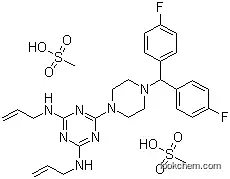-
Name
Almitrine dimesylate
- EINECS 249-726-1
- CAS No. 29608-49-9
- Density
- Solubility
- Melting Point 243° (dec)
- Formula C26H29F2N7.2(CH4O3S)
- Boiling Point 606.2 °C at 760 mmHg
- Molecular Weight 669.76
- Flash Point 320.4 °C
- Transport Information
- Appearance COA
- Safety
- Risk Codes
-
Molecular Structure
- Hazard Symbols
- Synonyms 6-[4-[bis(4-fluorophenyl)methyl]piperazin-1-yl]-N,N-diprop-2-enyl-1,3,5-triazine-2,4-diamine; methanesulfonic acid;Almitrine bismethane sulfonate;Almitrinum [INN-Latin];Vectarion;N,N-Diallyl-6-(4-(bis(4-fluorophenyl)methyl)piperazin-1-yl)-1,3,5-triazine-2,4-diamine dimethanesulphonate;Almitrine bismesylate;2,4-Bis(allylamino)-6-(4-(bis(p-fluorophenyl)methyl)-1-piperazinyl)-s-triazine;S 2620 bismethanesulfonate;Almitrin;Almitrina [INN-Spanish];1,3,5-Triazine-2,4-diamine,6-[4-[bis(4-fluorophenyl) methyl]-1-piperazinyl]-N,N'-di-2- propenyl-,dimethanesulfonate;6-(4-(Bis(4-fluorphenyl)methyl)-1-piperazinyl)-N,N-di-2-propenyl-1,3,5-triazin-2,4-diamin;N,N'-diallyl-6-[4-[bis(4-fluorophenyl)methyl]piperazin-1-yl]-1,3,5-triazine-2,4-diamine dimethanesulphonate;
- PSA 194.71000
- LogP 5.57570
Almitrine dimesylate Specification
The Almitrine dimesylate with its cas register number is 29608-49-9. It also can be called as 2,4-Bis(allylamino)-6-[4-[bis(p-fluorophenyl)methyl]-1-piperazinyl]-s-triazine dimethanesulfonate and the IUPAC Name about this chemical is 6-[4-[bis(4-fluorophenyl)methyl]piperazin-1-yl]-2-N,4-N-bis(prop-2-enyl)-1,3,5-triazine-2,4-diamine; methanesulfonic acid.
Physical properties about Almitrine dimesylate are: (1)ACD/LogP: 2.84; (2)#H bond acceptors: 7; (3)#H bond donors: 2; (4)#Freely Rotating Bonds: 8; (5)Polar Surface Area: 51.63Å2; (6)Enthalpy of Vaporization: 90.11 kJ/mol; (7)Vapour Pressure: 1.21E-14 mmHg at 25°C
The Almitrine dimesylate is a respiratory stimulant that enhances respiration by acting as an agonist of peripheral chemoreceptors located on the carotid bodies. The drug increases arterial oxygen tension while decreasing arterial carbon dioxide tension in patients with chronic obstructive pulmonary disease. It may also prove useful in the treatment of nocturnal oxygen desaturation without impairing the quality of sleep.
You can still convert the following datas into molecular structure:
(1)Canonical SMILES: CS(=O)(=O)O.CS(=O)(=O)O.C=CCNC1=NC(=NC(=N1)N2CCN(CC2)C(C3=CC=C(C=C3)F)C4=CC=C(C=C4)F)NCC=C
(2)InChI: InChI=1S/C26H29F2N7.2CH4O3S/c1-3-13-29-24-31-25(30-14-4-2)33-26(32-24)35-17-15-34(16-18-35)23(19-5-9-21(27)10-6-19)20-7-11-22(28)12-8-20;2*1-5(2,3)4/h3-12,23H,1-2,13-18H2,(H2,29,30,31,32,33);2*1H3,(H,2,3,4)
(3)InChIKey: MRDBGMJEPGXQHJ-UHFFFAOYSA-N
The toxicity data is as follows:
| Organism | Test Type | Route | Reported Dose (Normalized Dose) | Effect | Source |
|---|---|---|---|---|---|
| mouse | LD50 | intraperitoneal | 370mg/kg (370mg/kg) | Journal de Pharmacologie. Vol. 3, Pg. 363, 1972. | |
| mouse | LD50 | intravenous | 207mg/kg (207mg/kg) | Journal de Pharmacologie. Vol. 3, Pg. 363, 1972. | |
| mouse | LD50 | oral | > 2gm/kg (2000mg/kg) | Experientia. Vol. 28, Pg. 814, 1972. |
Related Products
- Almitrine
- Almitrine dimesylate
- Almitrine-raubasine
- 2960-93-2
- 2961-50-4
- 29616-23-7
- 29617-66-1
- 29620-62-0
- 29621-88-3
- 296240-54-5
- 296247-94-4
- 296251-72-4
- 29625-73-8
Hot Products
About|Contact|Cas|Product Name|Molecular|Country|Encyclopedia
Message|New Cas|MSDS|Service|Advertisement|CAS DataBase|Article Data|Manufacturers | Chemical Catalog
©2008 LookChem.com,License: ICP
NO.:Zhejiang16009103
complaints:service@lookchem.com Desktop View
